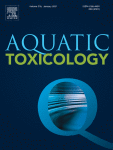Interplay between dietary lipids and cadmium exposure in rainbow trout liver: Influence on fatty acid metabolism, metal accumulation and stress response

The present study aimed at investigating interactive effects between dietary lipids and both short- and long-term exposures to a low, environmentally realistic, cadmium (Cd) concentration. We found that both dietary lipids and Cd exposure influenced fatty acid homeostasis and metabolism.
Scientific abstract
The present study aimed at investigating interactive effects between dietary lipids and both short- and long-term exposures to a low, environmentally realistic, cadmium (Cd) concentration. Juvenile rainbow trout were fed four isolipidic diets (31.7 g/kg) enriched in either linoleic acid (LA, 18:2n-6), alpha-linolenic acid (ALA, 18:3n-3), eicosapentaenoic acid (EPA, 20:5n-3) or docosahexaenoic acid (DHA, 22:6n-3). From the 4th week of this 10-week experiment, the lipid level of the diet was increased (120.0 g/kg) and half of the fish fed each diet were aqueously exposed to Cd (0.3 μg/L) while the other half were not exposed to Cd (control). Fish were sampled and their liver was harvested for fatty acid profile, hepatic Cd and calcium concentrations, total glutathione level and gene expression assessment, either (i) after 4 weeks of feeding and 24 h of Cd contamination (day 29) (short-term Cd exposure) or (ii) after 10 weeks of feeding and 6 weeks of Cd contamination (day 70) (long-term Cd exposure). We found that both dietary lipids and Cd exposure influenced fatty acid homeostasis and metabolism. The hepatic fatty acid profile mostly reflected that of the diet (e.g. n-3/n-6 ratio) with some differences, including selective retention of specific long chain polyunsaturated fatty acids (LC-PUFAs) like DHA and active biotransformation of dietary LA and ALA into LC-PUFAs. Cd effects on hepatic fatty acid profiles were influenced by the duration of the exposure and the nutritional status of the fish. The effects of diet and Cd exposure on the fatty acid profiles were only sparsely explained by variation of the expression pattern of genes involved in fatty acid metabolism. The biological responses to Cd were also influenced by dietary lipids. Fish fed the ALA-enriched diet seemed to be the least affected by the Cd exposure, as they showed a higher detoxifying ability against Cd with an early upregulation of protective metallothionein a (MTa) and apoptosis regulator BCL2-Like1 (BCLx) genes, an increased long-term phospholipid synthesis and turnover and fatty acid bioconversion efficiency, as well as a lower long-term accumulation of Cd in their liver. In contrast, fish fed the EPA-enriched diet seemed to be the most sensitive to a long-term Cd exposure, with an impaired growth performance and a decreased antioxidant capacity (lower glutathione level). Our results highlight that low, environmentally realistic aqueous concentrations of Cd can affect biological response in fish and that these effects are influenced by the dietary fatty acid composition.
Full reference (link):
Ferain, A., Delbecque, E., Neefs, I., Dailly, H., De Saeyer, N., Van Larebeke, M., Cornet, V., Larondelle, Y., Rees, J.-F., Kestemont, P., De Schamphelaere, K. A. C., & Debier, C. (2021). Interplay between dietary lipids and cadmium exposure in rainbow trout liver: Influence on fatty acid metabolism, metal accumulation and stress response. Aquatic Toxicology, 231, 105676. https://doi.org/10.1016/j.aquatox.2020.105676
